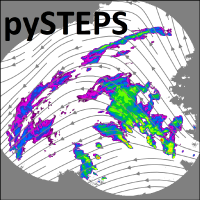pysteps.timeseries.autoregression.estimate_var_params_ols_localized
pysteps.timeseries.autoregression.estimate_var_params_ols_localized¶
- pysteps.timeseries.autoregression.estimate_var_params_ols_localized(x, p, window_radius, d=0, include_constant_term=False, h=0, lam=0.0, window='gaussian')¶
Estimate the parameters of a vector autoregressive VAR(p) model
\(\mathbf{x}_{k+1,i}=\mathbf{c}_i+\mathbf{\Phi}_{1,i}\mathbf{x}_{k,i}+ \mathbf{\Phi}_{2,i}\mathbf{x}_{k-1,i}+\dots+\mathbf{\Phi}_{p,i} \mathbf{x}_{k-p,i}+\mathbf{\Phi}_{p+1,i}\mathbf{\epsilon}\)
by using ordinary least squares (OLS), where \(i\) denote spatial coordinates with arbitrary dimension. If \(d\geq 1\), the parameters are estimated for a d times differenced time series that is integrated back to the original one by summation of the differences.
- Parameters
- x: array_like
Array of shape (n, q, :) containing a time series of length n=p+d+h+1 with q-dimensional variables. The remaining dimensions are flattened. The remaining dimensions starting from the third one represent the samples.
- p: int
The order of the model.
- window_radius: float
Radius of the moving window. If window is ‘gaussian’, window_radius is the standard deviation of the Gaussian filter. If window is ‘uniform’, the size of the window is 2*window_radius+1.
- d: {0,1}
The order of differencing to apply to the time series.
- include_constant_term: bool
Include the constant term \(\mathbf{c}\) to the model.
- h: int
If h>0, the fitting is done by using a history of length h in addition to the minimal required number of time steps n=p+d+1.
- lam: float
If lam>0, the regression is regularized by adding a penalty term (i.e. ridge regression).
- window: {“gaussian”, “uniform”}
The weight function to use for the moving window. Applicable if window_radius < np.inf. Defaults to ‘gaussian’.
- Returns
- out: list
The estimated parameter matrices \(\mathbf{\Phi}_{1,i}, \mathbf{\Phi}_{2,i},\dots,\mathbf{\Phi}_{p+1,i}\). If include_constant_term is True, the constant term \(\mathbf{c}_i\) is added to the beginning of the list. Each element of the list is a matrix of shape (x.shape[2:], q, q).
Notes
Estimation of the innovation parameter \(\mathbf{\Phi}_{p+1}\) is not currently implemented, and it is set to a zero matrix.
